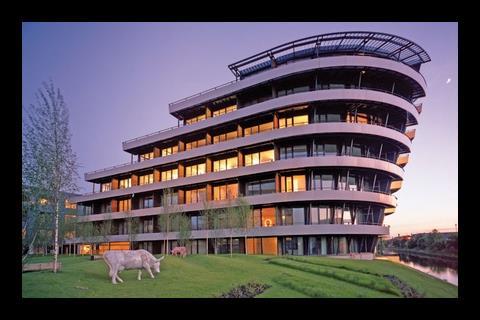With heating accounting for a significant proportion of the UK’s carbon emissions, finding viable alternatives to conventional systems is vital. Jon Dedman of Davis Langdon and Ben Madden of Element Energy look at different low-carbon heating strategies for new-build housing
The importance of current consultations on Heat and Energy Saving and Community Energy Saving has been emphasised in the recent Budget which has set a statutory carbon reduction target requiring a 16% cut in emissions between 2010 and 2020. Increasingly, the emissions reduction policy debate centres around existing dwellings, which represent the greatest practical and economic challenges and the greatest potential for reductions. However, with the target to build three million new homes by 2020 still in place, new build also provides an important market opportunity for alternative energy solutions, particularly when related to initiatives such as eco-towns. As housebuilders move towards levels five and six of the Code for Sustainable Homes, developments will have to feature a renewable or low-carbon energy source if they are to reach the net carbon reduction. Delivering this requirement in a flexible and cost-effective way will be a key challenge for housebuilders as they emerge from recession.
For existing housing, where ways to improve thermal performance might be limited due to the age of the building fabric, community heating will be one of the few options that can substantially reduce energy use and carbon emissions. Compared to solid wall insulation, it may also involve relatively low levels of disruption. However, for new build, there is a greater opportunity to mix and match different solutions and considerations related to market perception and cash flow management and so on may have significance in the final decision to invest.
Community heating options
Community heating systems consist of centralised boiler plant, an insulated hot water distribution system and a heat exchanger in each dwelling. The simplest system might comprise a central boiler in an apartment building whereas, as in Scandinavia, extensive systems can serve thousands of homes and businesses. Combined heat and power (CHP) systems can also be implemented as the heat source.
Considering the additional cost and large initial investment associated with a community heating scheme, the incentives to develop have to be considerable. The attractions include:
- Efficient combustion
- Accurate sizing for the diversity between base and peak load compared to individual boilers
- Ability to use non-fossil fuels including biomass and even waste
- Ability to use waste heat related to electricity generation (CHP) or industrial processes.
Community heating systems also benefit from a number of incentives introduced to encourage their adoption. These include:
- Exemptions to the climate change levy until 2013
- Enhanced Renewables Obligation Certificate entitlements (ROCs) for biomass-fired CHP
- Enhanced capital allowances providing 100% year one relief (available for clean CHP systems only)
Policy developments are likely to encourage community heating further. A feed-in tariff regime is soon to be implemented, providing revenue support for small renewable CHP systems (up to 5MWe) and a renewable heat incentive will encourage heat distributed from renewable sources (such as centralised biomass boilers).
Despite these incentives, schemes have been difficult to get off the ground, partially due to costs which can add between £75/m2 and £150/m2 to a residential development. Other significant barriers include:
- The cash flow and programme impacts of the infrastructure on a development
- Extended pay-back periods
- The requirement for a developer to identify a long-term supplier partner
- The potential need for an extended commercial investment in a scheme as a co-investor
- The absence of a regulated market for heat
- Uncertainty for investors regarding the value of incentives and the cost margin between community heating and competing energy suppliers.
With a great number of high density residential schemes being developed on urban brownfield sites in the UK, the potential for community heating is likely to grow. However, any growth will be determined in part by the relative competitive position of the technology in terms of cost and cost effectiveness.
The economics of community heating
The economics of community energy schemes are sensitive to many factors. In recent years, it has been possible to build an economic case on the basis of sale of services, such as heat and power, but also including additional services such as telecoms and broadband. In these instances, Energy Service Companies (ESCOs) have been attracted to deliver the system as a design, build, finance and operate contract.
However, changes in the wholesale energy markets, the slowdown in the housing market and uncertainties over the legality of private wire networks have contributed to undermine the economics of community heating. Recent discussions with ESCOs suggest that they will offer a capital contribution to a community system, based on 10-year revenue projections. In many cases this will leave a significant shortfall. As developers strive to meet tightening ��ɫ����TV Regulations and eventually the zero-carbon standard, they will incur additional costs. In this article, we explore what role community energy systems may play in least-cost solutions.
Cost analysis
The cost analysis featured in this article compares a matrix of schemes differentiated by development density, scheme size and technology. There are several main variables (see table 2).
The assessment is based on generic building models and current market costs. In addition to dwellings served by community solutions, the assessment includes dwellings designed on the lines of Passivhaus, using excellent fabric performance, air tightness, electric heating and renewables. All achieve zero net carbon emissions in accordance with the SAP calculation, which excludes the electrical load of appliances and non-essential lighting.
The analysis shows that community-based systems are a relatively cost effective method of delivering very low-carbon development, albeit that the cost increment is still fairly significant, ranging from £75/m2 to £150/m2 depending on the scheme configuration. It can be seen that the initial costs of the community heating or CHP infrastructure are significant, around £500,000 for the 200-dwelling scheme and £2.3 to £3.8 million for the 1,000-dwelling development. Furthermore, where a contribution from on-site renewables is required – in this case from photovoltaics (PVs) – further substantial investment is needed, together with the space for an extensive solar array – totalling 8,000m2 to 9,500m2 in the case of the 1,000-dwelling scheme.
By contrast, schemes which rely on high fabric performance, electric heating and a mechanical ventilation and heat recovery (MVHR) system have a higher electrical load which has to be served by PVs, resulting in a much higher initial cost, representing a cost uplift of over 30% on current Part L-compliant costs.
Biomass-based systems are the cheapest option as they require the lowest amount of PV to achieve the net carbon emissions. Due to limited availability of biomass CHP systems at small sizes, significant development scale is required to justify installation. In reality, biomass systems are only likely to be relevant in mixed-use schemes or very large developments. Where appropriate, they can provide low-cost solutions to large carbon reductions. However, the cost effect of density is complicated, particularly as costs related to a gas supply infrastructure are omitted. A higher heat density should improve the economics, and as dwelling density increases, infrastructure costs will be less significant.
The summary table also includes an assessment of the cost effectiveness of the carbon reduction of each system. This is based on an assessment of annual costs, including capital, finance, fuel and maintenance, and annual savings related to reduced gas and electricity consumption compared to a Part L 2006 compliant base case. The annual carbon saving is the reduction of carbon dioxide compared to the Part L base case.
Biomass again comes out lowest at £205/tonne of carbon saved per year. This is because biomass is effectively a zero-carbon energy stock. By contrast, the high-performance fabric solution is the least cost effective. Unfortunately, biomass is a limited resource and its use can be affected by issues of air quality. However, gas-fired CHP can be seen to be a better option than MVHR, which has a considerable electrical load.
Conclusions
The main conclusions that can be drawn are:
- Decarbonising domestic heating will be a substantial undertaking involving high premium costs
- Community-based heating systems have the potential to provide a low-carbon solution at a relatively low additional cost compared to other options, albeit that the cost premium of £75/m2 or more will have a significant impact on profitability and future land values
- Most community heating system configurations will require a significant component of electricity from renewables to meet net zero-carbon targets
- The extent of PVs required on some options could exceed the potential of a site
- As community systems are not currently viable on a commercial standalone basis, extensive take-up is unlikely until high carbon dioxide reduction is mandated by the ��ɫ����TV Regulations – probably from 2013 onwards.
Cost and cost effectiveness are of course only two factors in an investment decision. The timescales related to both payback periods and replacement cycles mean that these decisions have to be taken very carefully. Investment in a gas-fired CHP system will commit the investor to a highly efficient but ultimately fossil fuel-based technology with a life of at least 15 years. Will power generating technologies evolve over this period to make a hot-water-based heat distribution system prematurely obsolete? Particularly if the electricity grid carbon intensity were to fall at a faster rate than currently anticipated, technologies such as air cooled heat pumps could become an attractive approach in the longer term.
These are long-term considerations, however, and in the present market, community systems could be a good option for many schemes. With community heating systems involving premiums of 8% to 12% to deliver low-carbon heat, developers will face some difficult challenges as they approach the 2016 zero-carbon homes standard. Any steps that can be taken now to facilitate the investment in, or operation of, community heating markets will, in the long term, be very valuable.
Downloads
Postscript
Jon Dedman is head of energy at Davis Langdon, Ben Madden is a director at Element Energy.
Topics
The Regs Files 2009
- 1
- 2
- 3
- 4
- 5
- 6
- 7
- 8
 Currently reading
Currently readingHot topic: Alternative heating systems
- 9
- 10
- 11
- 12
- 13
- 14
- 15









































No comments yet